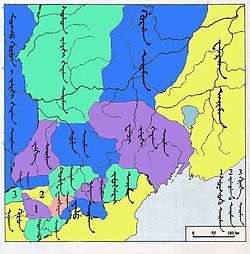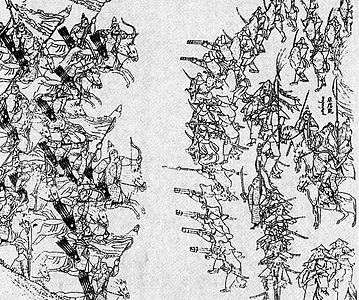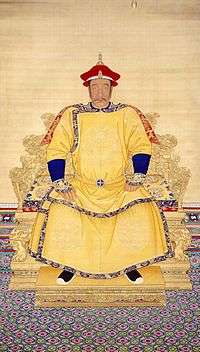Later Jin (1616–1636)
The Later Jin (1616–1636) was a dynastic khanate in Manchuria ruled by the Jurchen Aisin Gioro leaders Nurhaci and Hong Taiji. Established in 1616 by the Jianzhou Jurchen chieftain Nurhaci upon his reunification of the Jurchen tribes, its name was derived from the former Jurchen-led Jin dynasty which had ruled northern China in the 12th and 13th centuries before falling to the Mongol Empire (China's Yuan dynasty). In 1635, the lingering Northern Yuan under Ejei Khan formally submitted to the Later Jin. The following year, Hong Taiji officially renamed the realm to "Great Qing", thus marking the start of the Qing dynasty. The Qing subsequently overran Li Zicheng's Shun dynasty and various Southern Ming claimants and loyalists, going on to rule an empire comprising China proper, Tibet, Manchuria, Mongolia, Xinjiang, and Taiwan until the 1911 Xinhai Revolution established the Republic of China.
Jin State ᠮᠠᠨᠵᡠ ᡤᡠᡵᡠᠨ or ᠠᡳ᠌ᠰᡳᠨ ᡤᡠᡵᡠᠨ Aisin gurun 金國 | |||||||||||||
|---|---|---|---|---|---|---|---|---|---|---|---|---|---|
| 1616–1636 | |||||||||||||
 Later Jin (后金) c. 1626 shown in light green | |||||||||||||
| Status | Khanate | ||||||||||||
| Capital | |||||||||||||
| Common languages | Jurchen (renamed Manchu after 1635), Mongolian, Chinese[1] | ||||||||||||
| Government | Absolute monarchy | ||||||||||||
| Khan | |||||||||||||
• 1616–1626 | Nurhaci | ||||||||||||
• 1626–1636 | Hong Taiji | ||||||||||||
| Historical era | Imperial era | ||||||||||||
• Enthronement of the Tianming Khan | 1616 | ||||||||||||
• Proclamation of the Seven Grievances | 1618 | ||||||||||||
| 1619 | |||||||||||||
• Annexation of the Northern Yuan | 1635 | ||||||||||||
| 1636 | |||||||||||||
| Currency | Chinese coin, Chinese cash | ||||||||||||
| |||||||||||||
| Today part of | China Mongolia Russia North Korea | ||||||||||||
| Later Jin | |||||||||
|---|---|---|---|---|---|---|---|---|---|
| Chinese name | |||||||||
| Traditional Chinese | 後金國 | ||||||||
| Simplified Chinese | 后金国 | ||||||||
| Literal meaning | Later Gold(en) State | ||||||||
| |||||||||
| Manchu name | |||||||||
| Manchu script | ᠠᠮᠠᡤᠠ ᠠᡳᠰᡳᠨ ᡤᡠᡵᡠᠨ | ||||||||
| Romanization | (Amaga) Aisin Gurun | ||||||||
 | ||||||||
|---|---|---|---|---|---|---|---|---|
| ANCIENT | ||||||||
| Neolithic c. 8500 – c. 2070 BCE | ||||||||
| Xia c. 2070 – c. 1600 BCE | ||||||||
| Shang c. 1600 – c. 1046 BCE | ||||||||
| Zhou c. 1046 – 256 BCE | ||||||||
| Western Zhou | ||||||||
| Eastern Zhou | ||||||||
| Spring and Autumn | ||||||||
| Warring States | ||||||||
| IMPERIAL | ||||||||
| Qin 221–207 BCE | ||||||||
| Han 202 BCE – 220 CE | ||||||||
| Western Han | ||||||||
| Xin | ||||||||
| Eastern Han | ||||||||
| Three Kingdoms 220–280 | ||||||||
| Wei, Shu and Wu | ||||||||
| Jin 266–420 | ||||||||
| Western Jin | ||||||||
| Eastern Jin | Sixteen Kingdoms | |||||||
| Northern and Southern dynasties 420–589 | ||||||||
| Sui 581–618 | ||||||||
| Tang 618–907 | ||||||||
| (Wu Zhou 690–705) | ||||||||
| Five Dynasties and Ten Kingdoms 907–979 |
Liao 916–1125 | |||||||
| Song 960–1279 | ||||||||
| Northern Song | Western Xia | |||||||
| Southern Song | Jin | Western Liao | ||||||
| Yuan 1271–1368 | ||||||||
| Ming 1368–1644 | ||||||||
| Qing 1636–1912 | ||||||||
| MODERN | ||||||||
| Republic of China on mainland 1912–1949 | ||||||||
| People's Republic of China 1949–present | ||||||||
| Republic of China on Taiwan 1949–present | ||||||||
Part of a series on the |
|---|
| History of Manchuria |
 |
|
Ancient period
|
|
Modern period |
Name
Historians debate whether the official Chinese name of the state was "Jin" (金, Jīn), "Later Jin" (後金, Hòu Jīn), or both. Either describes it as a continuation or successor to the Jurchen Jin state established by the Wanyan clan in 1115. The Manchu form of the name was ᠠᡳ᠌ᠰᡳᠨ ᡤᡠᡵᡠᠨ (Aisin Gurun),[2] meaning simply "Golden State".
History
Rise of Jianzhou Jurchens
The Jurchen people had traditionally lived in Manchuria and were then divided into three tribes, the most powerful of which during the Ming dynasty was called Jianzhou Jurchens, living around the Changbai Mountains. In order to attack and suppress the Northern Yuan dynasty, the Hongwu Emperor sent military commissions to gain control of the Jurchen tribes in Manchuria. The Ming government divided the Jianzhou Jurchens into three wei (a military subdivision during the Ming dynasty), collectively known as the "Three Wei of Jianzhou". The leaders of the Jurchen tribes were usually chosen as commanders of the wei.
The northern tribe Wild Jurchens were strong at that time, and attacked the Jianzhou Jurchens. Mengtemu, commander of the Jianzhou Wei, was killed. The Jianzhou Jurchens were forced to move southwards, and finally settled at Hetu Ala.
Establishment of the Khanate
Nurhaci, a Jurchen khan, promoted the unification of the Jurchens living in Manchuria at the beginning of the 17th century. He organized "Banners", military-social units that included Jurchen, Han Chinese, and Mongol elements. Nurhaci formed the Jurchen clans into a unified entity (which was renamed "Manchu" in 1635 by Hong Taiji), completing the establishment of the new state in 1616. This marks the start of the Later Jin dynasty.
Expansion
Nurhaci, originally a Ming vassal, took a hostile attitude towards the Ming for favoritism and meddling in the affairs of the Jurchen tribes. In 1618, he proclaimed his Seven Grievances (nadan amba koro; 七大恨) which effectively declared war on the Ming dynasty. He occupied Fushun, Qinghe (清河) and other cities before retreating. The death of the Ming Vice-General Zhang Chengyin (張承蔭) during the Battle of Fushun stunned the Ming court. In 1619, he attacked the Yehe (葉赫) in an attempt to provoke the Ming. The Ming responded by dispatching expeditionary forces led by Military Commissioner Yang Hao along four routes to besiege Hetu Ala. In a series of winter battles known collectively as the Battle of Sarhū Nurhaci broke three of the four Chinese Ming armies, forcing the survivors and the fourth to retreat in disorder. This caused the power sphere of the Later Jin to extend over the entire eastern part of Liaoyang.
Relocating his court from Jianzhou to Liaodong provided Nurhaci access to more resources; it also brought him in close contact with the Khorchin Mongol domains on the plains of Mongolia. Although by this time the once-united Mongol nation had long since fragmented into individual and hostile tribes, these tribes still presented a serious security threat to the Ming borders. Nurhaci's policy towards the Khorchins was to seek their friendship and cooperation against the Ming, securing his western border from a powerful potential enemy.[3]
The unbroken series of military successes by Nurhaci came to an end in January 1626 when he was defeated by Yuan Chonghuan while laying siege to Ningyuan. He died a few months later and was succeeded by his eighth son, Hong Taiji, who emerged after a short political struggle amongst other potential contenders as the new khan.
Although Hong Taiji was an experienced leader and the commander of two Banners at the time of his succession, his reign did not start well on the military front. The Jurchens suffered yet another defeat in 1627 at the hands of Yuan Chonghuan. As before, this defeat was, in part, due to the Ming's newly acquired Portuguese cannons.
To redress his technological and numerical disparity, Hong Taiji in 1634 created his own artillery corps, the ujen cooha (Chinese: 重軍) from among his existing Han troops who cast their own cannons in the European design with the help of defector Chinese metallurgists. One of the defining events of Hong Taiji's reign was the official adoption of the name "Manchu" for the united Jurchen people in November 1635. In 1635, the Manchus' Mongol allies were fully incorporated into a separate Banner hierarchy under direct Manchu command. Hong Taiji conquered the territory north of Shanhai Pass by Ming Dynasty and Ligdan Khan in Inner Mongolia. In April 1636, Mongol nobility of Inner Mongolia, Manchu nobility and the Han mandarin held the Kurultai in Shenyang, recommended the khan of Later Jin to be the emperor of the Great Qing empire. One of the Yuan dynasty's jade seals was also dedicated to the emperor (Bogd Sécén Khaan) by nobility. When he was said to be presented with the imperial seal of the Yuan dynasty by Ejei Khan, Hong Taiji renamed his state from "Jin" to "Great Qing" and elevated his position from Khan to Emperor, suggesting imperial ambitions beyond unifying the Manchu tribes, and marking the formal end of the Later Jin period.
Aftermath
This was followed by the creation of the first two Han Banners in 1637 (increasing to eight in 1642). Together these military reforms enabled Hong Taiji to resoundingly defeat Ming forces in a series of battles from 1640 to 1642 for the territories of Songshan and Jinzhou. This final victory resulted in the surrender of many of the Ming dynasty's most battle-hardened troops, the death of Yuan Chonghuan at the hands of the Chongzhen Emperor (who thought Yuan had betrayed him), and the complete and permanent withdrawal of the remaining Ming forces north of the Great Wall.
Hong Taiji died suddenly in September 1643 without a designated heir. His five-year-old son, Fulin, was installed as the Shunzhi Emperor, with Hong Taiji's half brother Dorgon as regent and de facto leader of the Qing dynasty.
In 1644, Shun forces led by Li Zicheng conquered the Ming capital, Beijing. Rather than serve them, Ming general Wu Sangui made an alliance with the Manchus and opened the Shanhai Pass to the Banner armies led by Dorgon, who defeated the rebels and seized the capital. Remnants of the Ming imperial house remained in control of southern China as the Southern Ming dynasty.
Gallery
 Later Jin cavalry charging Ming infantry in the Battle of Sarhū.
Later Jin cavalry charging Ming infantry in the Battle of Sarhū. Official portrait of Nurhaci, the founder of the Later Jin dynasty.
Official portrait of Nurhaci, the founder of the Later Jin dynasty. Official portrait of Hong Taiji, the second khan of the Later Jin dynasty and subsequently the founder of the Qing dynasty.
Official portrait of Hong Taiji, the second khan of the Later Jin dynasty and subsequently the founder of the Qing dynasty..jpg) Dorgon, the Prince Rui.
Dorgon, the Prince Rui.
References
- Hong Taiji mediator wood letter card,have three languages of Manchu,Mongolian and Chinese. Chinese Economy (in Chinese). 2008-02-18. Retrieved 2013-04-28.
- Manju i Yargiyan Kooli (滿洲實錄). Zhonghua Book Company, p. 283.
- Bernard Hung-Kay Luk, Amir Harrak-Contacts between cultures, Volume 4, p.25